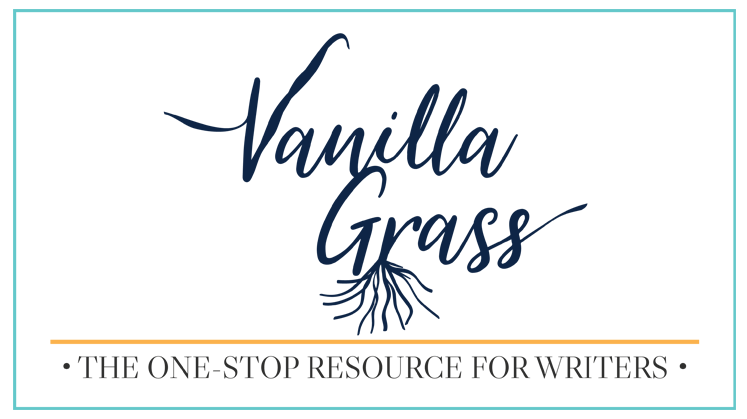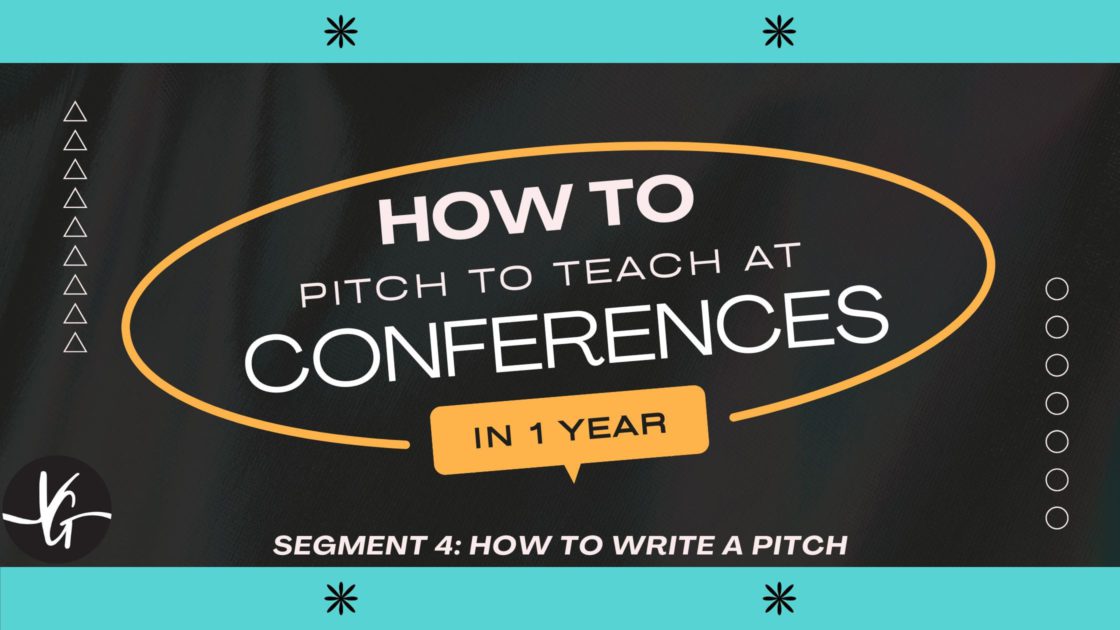This week’s learning post is on the nuts and bolts of writing a pitch to teach at conferences! If you’re wondering what classes to submit, what qualifications to put down, and how to wrap it all up in an appealing little bundle, this is the post for you!
Hopefully, you’re either working on some of the things from the past posts (like why teaching at conferences is important to your career, how to build your conference credentials, and how to know what to teach) or already have some skills ready to present and show off! If not, go read those and make some notes before you jump into this next bit.
Writing a Pitch: How Do I Submit a Strong Application to Teach at a Conference?
- Gather your credentials.
- Show the qualifications that really matter.
- Be flexible and give them lots of options!
Let’s start with:

Step One: Gathering Your Credentials
Remember all those things you’ve been working on or have been improving on since you started writing? This is the part where we write those all down in a list. Include big accomplishments and small wins, things directly related to writing, and any others you may have as well that fit into the business, time management, personal well-being, motivation, etc. categories.
Next, sort those items based on what you want to teach. Maybe you have an idea for a craft class on point of view, a business class on marketing ads, and a well-being class on writer’s block. Parse your qualifications out into which classes they help give you credibility in. They can definitely go in more than one!
Once that’s done, take each item you wrote down and break it down even further. If you mentioned that you ran Facebook ads for a year, let’s dive deeper. Proving authority is a well-known marketing technique and right now, you’re trying to sell yourself!
How much did your stats improve from the beginning to now? If your CTR rate was a dismal 1.2% and shot up to 12% — write it down! Even if it only went from 1.2% to 3%, write it down!

Do this for each item, breaking it down into each nitty gritty piece and taking care to look up any statistical info you can about it. This includes steps in the process. Running Facebook ads for a year sounds okay, but if you made the ads, tracked the data, ran the ads, made periodic adjustments, and saw positive results–write that all down!
Once you’ve broken down each piece in each class category, move on to step 2.
Step Two: Showing the Qualifications That Really Matter!
Writing a pitch for a conference is a lot like applying for a job. If you’re too vague or focus on the wrong pieces, you’re likely to get overlooked. This section is about taking that nitty gritty list you made and polishing it down to what matters most.
So, what matters most when pitching to teach at conferences?
- Results
- Confidence
- Directness
- Relevancy to what you’re teaching
- Preparation
What does that mean for your application?
Usually, when filling out an application, there are two parts. The first part goes over your qualifications and the second part is what you want to teach. Sometimes, these are flip-flopped but will be there either way. In the qualifications section, you want to highlight why you are the best one to teach this job, This is where Results, Confidence, Directness, and Relevancy come into play.
But what does that look like on paper?

Let’s go through an example of how I might word it to try to pitch to a conference with my credentials using the first two steps and what matters most.
Conference Application Example:
Let’s say I want to teach a class on growing newsletters.
Step One for Writing a Pitch
I look through my list of credentials and identify and pull over the qualifications that most match what I want to teach. You can think outside the box but focus on relevancy. Don’t include things that don’t help with the subject of what you are hoping to teach. In our newsletter example, these include that I started a newsletter and have been sending out bi-monthly emails for a year and that I run a blog.
Now, let’s break those down further:
Sending out a newsletter for a year also includes:
- Curating content to engage with my audience
- Learning how to run automations and onboarding campaigns
- Collecting and qualifying email addresses in person and online
- Offering free promos
- Selling product through emails
Alright. That’s looking better, don’t you think? I went from a vague qualification to a list of actionable qualifications that look legitimate and make me sound more like I know what I’m doing.
How do we make it even better?

Step Two For Writing a Pitch
By adding stats and specifics! Or, in other words, results! But what stats can we add? Let’s look at the list above and see which one(s) can be bolstered by relevant numbers and detailed results.
Pitch Improvement #1
What about running automations and onboarding campaigns? I could bolster this by saying I set up onboarding for 8 different books in 2 differents series. I could also say that I’ve run automations for 3 different bundle deals, promoted multi-platform sales, and run 2 successful giveaways using my email platforms.
Now we sound like we really know what we’re talking about, have done everything we want to teach, and have had success.
Pitch Improvement #2
Another example would be collecting and qualifying email addresses. I could go back through and see how I’ve improved over the year(s). If I go back and take a look, I see that I started with 70 people at the beginning of the first year and ended with 700. I could also see that the next year I went from 700 to 1400 subscribers.
That means I could take that stat and say in my application that I grew 1000% my first year and doubled my subscribers the next!

That sounds pretty cool and very confident. It also shows that the crazy big number in the first year isn’t out of place. It’s easy to grow big numbers in your first year, but to double it again the next shows you’re consistently growing. To sound confident and direct, you could also phrase this as achieved substantial growth two years in a row or over doubled my mailing every year since I started.
They’re both true. They’re both impressive. They’re both direct and relevant statements. And they both exude confidence when writing a pitch.
See why making that list and getting the nitty gritty details from it was so important?
Just remember:
Never lie or stretch the truth to sound better. Industry professionals know what realistic improvements look like and unless you’re starting out as a best seller in your first year, your numbers will fall in line with other more moderately successful writers and authors. It’s also rude and will get you in trouble when you’re eventually caught.
Do the same thing for each of the points you listed that will help prove your credentials but remember to be direct. Don’t wander in your descriptions. They don’t want to hear about how you gained ten then twenty then fifty followers then had a slump then had success again! This is pitch. It should be concise, full of results, and to the point. You can save the hardship stories for your class!

Writing a Pitch Side Note:
A pitch to teach at a conference is no time for filler or doubt words. Self-deprecation can do a lot for making friends and playing with humor, but it’s not what conference directors want to see in their teachers! This means removing or replacing words like:
- Almost: (Use approximately instead.) Ex: I almost doubled my subscribers in a year. Not great. Better Ex: I approximately doubled my subscribers in a year. Much better. If you’re within a hundred of doing so, approximately works great and sounds a lot more professional!
- Feel like: (cut it!) Ex: I feel like I’m a good candidate because–. Not great. Better Ex: I am the best candidate to teach a class on X because–
- A lot: (Use specifics instead) Ex: I’ve grown a lot since I started. Or: I know a lot about emails because– Not great. Better Ex: I’ve grown my skills in automation and campaigns since I started by doing X, Y, and Z. Or: I have a deep understanding of the different mechanics that go into email automations, including X, Y, and Z.
Step 3: Being Flexible and Giving Options
Remember when I said there are two parts to every conference application? This section focuses on the second part, or pitching your class!
This step also involves the last bullet point in the things that matter most list: Preparation!

Your pitch for the class should be as good as the pitch you would give to someone you wanted to come to it. That sounds obvious, but a lot of times, prospective teachers blow off the application, slap down some quick sentences about what they could teach, and then move on.
That’s a wasted opportunity.
You don’t need to have a full presentation done (though once you start teaching you will have ready presentations you can pitch), but you should at least have an outline of what you’re going to go over.
Writing a class outline for each class you’re pitching will help you write a better pitch, give you ideas for additional classes, and save you time when submitting so you do not have to pause and craft one for each class.
Every conference I’ve pitched to teach at has also asked for a class description that’s a few sentences long and half have asked for an outline and/or optional handout. Don’t skimp on those! Providing a handout adds extra value to the conference and therefore extra value to you as a potential teacher.
How do I write a conference class description?

Writing a conference class description is like writing a super condensed first chapter. You need a hook, some meat, and another hook.
Starting Hook (SH)
Often, the first hook presents a problem or question that you are going to answer. This can often be done in question format.
Meat (M)
The meat of your pitch addresses the problem directly and indicates what you’re teaching about.
Ending Hook (EH)
The ending hook for your conference pitch involves a sneak peek into the solution you’re offering.
Let’s give it a try with a few examples:
Writing a Pitch for Classes Examples:

(SH) Ever been stuck in a writing rut you just can’t get out of? – This asks a question that writers might want to know the answer to.
(M) You’re not alone. Writer’s block has foiled many brilliant authors and wasted hours of valuable creativity! – This section states the problem outright, expounds on why it’s bad and needs to be solved, and shows it’s relatable to a large group of people.
(EH) Come learn three easy steps for overcoming writer’s block and get back to crafting your novels! – This part promises you have the answer and that it’s easy.
Here’s another example, only this time, see if you can break it down into the three parts and label why they were included.
Heard of show don’t tell but wish someone would just show you what that means!? Learning how to show instead of tell with your writing is key to an amazing reader experience. This class will go over how to show instead of tell and involve hands-on exercises so you leave the class an expert!
Can you see the starting hook, meat, and ending hook in the pitch?
Go and write at least three each for the classes you want to pitch to teach!

Side note:
This is not the only formula that works, it’s just an example of formula that has worked for me several times in the past. Look at the class descriptions for the conferences you love to attend and see how they’re laid out. Those are the pitches the teachers submitted to the conference committee that won and are invaluable resource in practicing your pitch!
Giving Options to the Conference Committee
An essential part of teaching at conferences is to give the committee that’s making the decisions lots of options! Be flexible with the times you’re available and provide lots of class options! If you pitch an equally awesome class as Sally Sue but she’s available all day every day and you’re not, they’ll probably pick Sally Sue. Being picky about your schedule or preferences is an option afforded to those with long-established credentials who are sought after. If you’re pitching to a conference instead of them pitching to you, you haven’t made it yet!
You need to give cookies to receive cookies. Be flexible at the start of your career and maybe one day you can be particular too!
As for class options, pitch as many as you have the energy to pitch or as many as they’ll let you if there’s a cap. Here are three good reasons. why:
- You are more likely to hit on a class they’re looking for.
- You sound like an expert on lots of things instead of just one, and that’s just good for business.
- They see your name over and over and over, making you more memorable!
Life Example of Priorities

When I got my first gig at a conference, it was as a panelist for Life The Universe and Everything (LTUE). I signed up for as many panels as possible and said I was available whenever. I was chosen! And given five classes at the worst possible times while I was juggling being a mom of four. I made it work. The next year, I did the same and was assigned seven classes at the worst possible time while being a newly single mom of four. I made it work but it was really hard!
The next year . . . I decided I couldn’t do another crazy schedule. Why? I had either taught at or attended 12 conferences the year before and was exhausted. I wanted to prioritize family and health. So I pitched for only a few classes at times they were at school and . . . I was not chosen!
But I was also okay with it. I knew pitching with a limited schedule would hinder my chances but decided that with my priorities, I was okay with it.
If being super flexible and pitching a ton of classes doesn’t sound like it fits in your priorities, that’s okay! You could start a substack or build your credentials enough in other ways that you can be more selective. You can also pitch anyway and see what comes of it! These are tips for helping you have the best chance at getting chosen, it doesn’t mean you won’t be if you don’t do these things.
But if you for sure want to teach at conferences, BE FLEXIBLE AND OFFER LOTS OF CLASSES!

Side Note:
You can take a topic you are familiar with and break it down into more specific classes! If you rock at time management, consider offering a class on priorities, a class on scheduling, and a class on positive mindsets! Then offer a class that encompasses all of them. You never know what a committee is looking for!
For one writing conference, I wanted to pitch to teach classes on Kickstarter. I could have just pitched a class on that as a whole but chose to break it down into who is a good candidate for crowdfunding and how to run a successful campaign. The first was chosen!
Explore each bullet point in your list and see which ones are substantial enough to have a class and which ones you can combine to focus on different elements. Maybe the committee has seen a ton of classes on what to include in a newsletter but not a ton on where to find subscribers who are worth it.
How to Write a Pitch Conclusion
Ready to go pitch at writing conferences?
Using these methods has helped me land teaching gigs at over 7 conferences in a single year! Remember, be confident and specific!
Join us next week for a blog post on how to choose which conferences to pitch at and how to know what they’re looking for!

